International Journal of Advancements in Technology
Open Access
ISSN: 0976-4860
ISSN: 0976-4860
Research Article - (2023)Volume 14, Issue 5
In recent decades, vegetal concretes have attracted great interest from the civil engineering research community. Besides their low environmental footprint, these materials have interesting thermal, acoustic and hydric properties. However, their mechanical performance is low compared to the materials commonly used in construction (reinforced concrete, wood), which limits the attractiveness of vegetal concretes in construction. It is aimed to overcome this weakness by proposing a strengthening solution using materials with good mechanical properties such as fiber reinforced cementitious materials. Therefore, at the first stage, this paper briefly summarizes what fabric reinforced cementitious matrix as a composite material for natural materials is, and how to behave under tensile forces investigated on a simple experimental study, in which also covers the comparison theoretical models with the experimental results obtained from tensile testing.
Fabric reinforced cementitious matrix; Tensile strength; Vegetal concrete; Construction materials
In recent times, there has been a surge of interest in sustainable building materials that not only reduce environmental impact but also ensure structural robustness. Among these innovations is vegetal concrete, also referred to as plant based or bio based concrete. By incorporating materials derived from plants, this environmentally friendly alternative offers distinct mechanical behavior, holding immense promise for the construction industry. However, their mechanical performance is low compared to the materials commonly used in construction (reinforced concrete, wood), which limits the attractiveness of vegetal concretes in construction. Composite materials for retrofitting and strengthening of such materials, whose performances are low, have skyrocketed, which has gained motivation in large research areas and application in engineering practice. One of the materials that has been used as reinforcement is fiber-reinforced cementitious systems that are highly preferred for high tensile strength to weight ratio, the ease of application (as an external bonding) and gain in higher ductility especially in columns. Nevertheless, such materials can have certain drawbacks due to their resin based (and hence organic) matrix, including sensitivity to low/high temperatures, vapor impermeability, flammability, inapplicability on wet surfaces or at low temperatures. That is why an inorganic matrix is used to overcome its limitations and to be named as Fabric Reinforced Cementitious Matrix. FRCM behavior heavily depends on the composite action of single/multiple fiber grids embedded within the matrix, as well as their interaction with the substrate. The matrix consists of: a) Cement based mortar, b) lime based mortar, or c) a geopolymer, which may include chopped fibers and/or low-content polymeric addition. The composite grid is made of such artificial members as aramid, basalt, carbon, glass, polypara Phenylene Benzobisoxazole (PBO), steel and such natural fibers as jute, flax, and hemp. FRCM composites have also been identified in the literature as Textile Reinforced Mortar (TRM), and Textile Reinforced Concrete (TRC). In this experimental study, only glass fibers as an inorganic fiber, and cementitious mortar are used to investigate the mechanical behavior of FRCM.
Vegetal concrete
Vegetal concrete, also known as plant-based or bio-based concrete, is a type of concrete that incorporates plant-derived materials as partial replacements for traditional concrete constituents like cement and aggregates. It offers several unique mechanical properties compared to conventional concrete [1]. The vegetal concrete can be mixed with binders or chemical additives to reduce its disadvantages in terms of mechanical performance, shown on example study in Figure 1 [2].
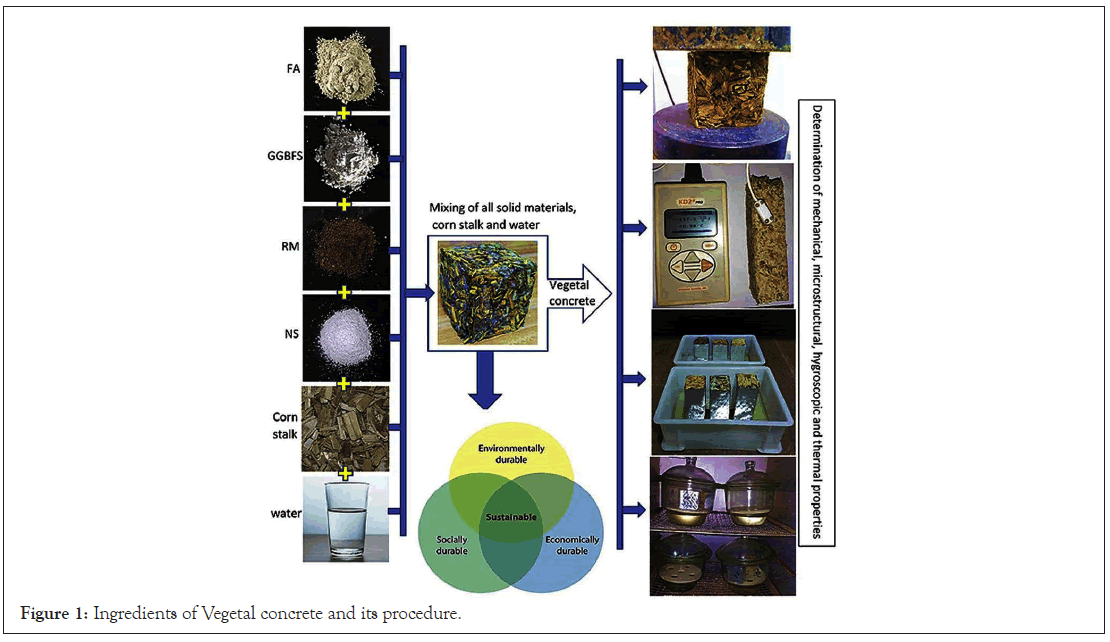
Figure 1: Ingredients of Vegetal concrete and its procedure.
Vegetal concrete demonstrates commendable compressive strength, signifying its ability to withstand forces that compress or squeeze the material. The specific composition of plant-based materials employed significantly influences this property. By carefully selecting and balancing these constituents, engineers can customize the compressive strength to meet precise project requirements [3].
While vegetal concrete may exhibit slightly lower tensile strength compared to traditional concrete, the inclusion of plant fibers can bolster its resistance to tension. These fibers serve as reinforcements, reducing the occurrence of cracks and enhancing the overall tensile characteristics of the material [4].
Flexural strength, which gauges a material’s capacity to endure bending or deformation, plays a vital role in construction. Vegetal concrete can achieve satisfactory flexural strength, particularly when supplemented with plant fibers or other additives. This reinforcement enhances its ability to withstand bending forces, ensuring structural stability [5].
Evaluating the long-term performance of vegetal concrete necessitates careful consideration of its durability. By meticulously selecting appropriate plant based materials and employing suitable processing techniques, engineers can achieve impressive durability. Vegetal concrete exhibits resistance to freezing and thawing cycles and is less susceptible to chemical attacks, establishing it as a viable option for sustainable construction projects [6].
Compared to conventional concrete, vegetal concrete demonstrates lower thermal conductivity. This advantage can be attributed to the incorporation of plant derived constituents such as wood particles or fibers. By reducing heat transfer, vegetal concrete provides enhanced thermal insulation properties, making it suitable for applications where temperature regulation is crucial [7,8].
A notable benefit of vegetal concrete lies in its reduced density. Incorporating plant based materials results in a lighter material, offering advantages such as decreased weight during construction and improved energy efficiency. This characteristic expands the potential applications of vegetal concrete. Regarding the performance of vegetal concrete, the study conducted by focused on investigating the durability of vegetal concrete when exposed to harsh environmental conditions. The researchers examined the effects of immersion weathering, outdoor weathering, salt assault, and freeze-thaw attack on the properties of vegetal concrete samples. The results of the study indicated that all the samples exposed to these weathering conditions experienced a reduction in mass, shrinkage of sample area, and a decrease in compressive strength. However, the researchers found that certain measures could enhance the durability performance of vegetal concrete under adverse weather conditions. Incorporating fly ash as a supplementary cementitious material, achieving high compaction during the concrete mixing process, and using pre- treatment aggregates were identified as factors that could improve the durability of vegetal concrete showing in Figure 2.
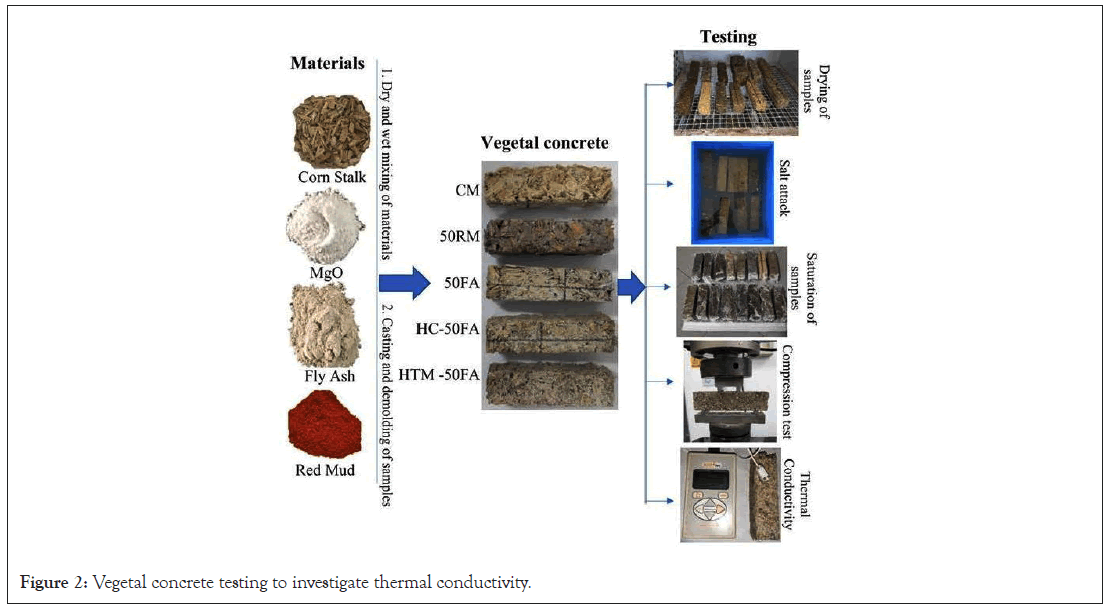
Figure 2: Vegetal concrete testing to investigate thermal conductivity.
These measures contributed to mitigating the negative effects of harsh environmental conditions on the material. The study by highlights the importance of considering these factors and employing suitable techniques to enhance the durability of vegetal concrete in practical applications subjected to extreme weather conditions.
Fabric reinforced cementitious matrix
Fabric Reinforced Cementitious Matrix (FRCM) composite materials utilize reinforcing fabrics, such as carbon, glass, or PBO, which possess exceptionally high tensile strength and stiffness along the fiber direction. In contrast, the inorganic matrix typically exhibits poor tensile behavior, characterized by severe cracking and low tensile strength. When subjected to tensile loading, the fabric primarily absorbs the tensile stresses, while the matrix plays a vital role in safeguarding the fibers and distributing the stresses among them [9]. Figure 3 shows the typical fibers for the externally wrap of materials. However, the tensile behavior of FRCM is significantly influenced by the mechanical interaction that occurs between the inorganic matrix and the fabric as the matrix undergoes rapid cracking within the specimen. Unlike conventional Fiber Reinforced Polymers (FRPs), where the polymeric matrix can accommodate substantial strains until fiber breakage, FRCM exhibits a different response. The matrix cracking process in FRCM occurs quickly, necessitating the subsequent mechanical interaction between the matrix and the fabric [10,11]. This unique characteristic of FRCM distinguishes it from conventional FRPs and underscores the need to understand the intricate interplay between the inorganic matrix and the reinforcing fabric in determining the overall tensile behaviour of FRCM composite materials. Further exploration and research are required to fully comprehend and optimize the mechanical performance of FRCM in various applications [12,13]. Previous studies on FRCM have focused on understanding its mechanical behaviour, optimizing its performance through material selection and design, assessing its durability, and utilizing numerical modeling to predict and analyze its performance. These studies provide valuable insights for the practical application of FRCM in structural engineering.
Table 1 presents an overview of the textiles used in Fabric Reinforced Cementitious Matrix (FRCM) studies, along with their corresponding grid spacing, design thickness (t), surface mass density (g), and mechanical properties. The mechanical properties include tensile strength (ft) and its corresponding strain (ε tensile). Shear bond tests are conducted on specimens created by affixing a reinforcement strip onto a substrate, such as brick, stone unit, or concrete block, in accordance with the installation guidelines provided by the supplier. Two approaches can be employed: The single-lap scheme or the double-lap scheme. The single-lap scheme offers the advantage of clear load identification but demands precise alignment of the specimen to ensure that only shear stress is applied to the reinforcement. This prevents the outcome from being influenced by unwanted normal stresses at the interface between the substrate and the matrix. On the other hand, the double-lap scheme involves applying the reinforcement to both sides of the specimen, ensuring symmetry in the system’s geometry (Figure 3).
| Section | Length of measurement (LVDT) | Etextile | Ematrix | Reinforcement rate |
|---|---|---|---|---|
| 550 mm2 | 45 cm | 35 GPa | 4 GPa | 0.02% |
Note: a Dimensional features.
Table 1: Tensile test on TRC (glass grid+cementitious matrix).

Figure 3: Reinforcement fabric types: (a) Balanced bidirectional basalt-stainless steel mesh, (b) Balanced bidirectional carbon mesh, (c) Unbalanced bidirectional glass-aramid mesh and (d) Unidirectional UHTSS textile geometry.
However, this does not guarantee an equal distribution of the load on both surfaces, necessitating careful evaluation of the actual force applied to each side. In shear bond tests, the load is applied gradually and continuously while maintaining control over the displacement until failure occurs. It is worth noting that shear bond tests are typically conducted at a slower rate compared to tensile tests. Alongside measuring the force, other parameters recorded include the relative displacement between the reinforcement and substrate at the loaded end of the bonded area, as well as the strain of the unbonded textile. The occurrence of different failure modes (depicted in Figure 4) is influenced by various factors such as the substrate properties, the shear strength of the mortar matrix, the tensile strength of the textile, and the bond or interlocking between the textile and the matrix. These failure modes include: Debonding with cohesive failure in the substrate (mode A), debonding at the interface between the reinforcement and substrate (mode B), debonding at the interface between the textile and matrix (mode C), sliding of the textile within the thickness of the reinforcement (mode D), and tensile rupture of the textile either in the unbonded portion (mode E) or within the mortar matrix (mode F) (Figure 4).
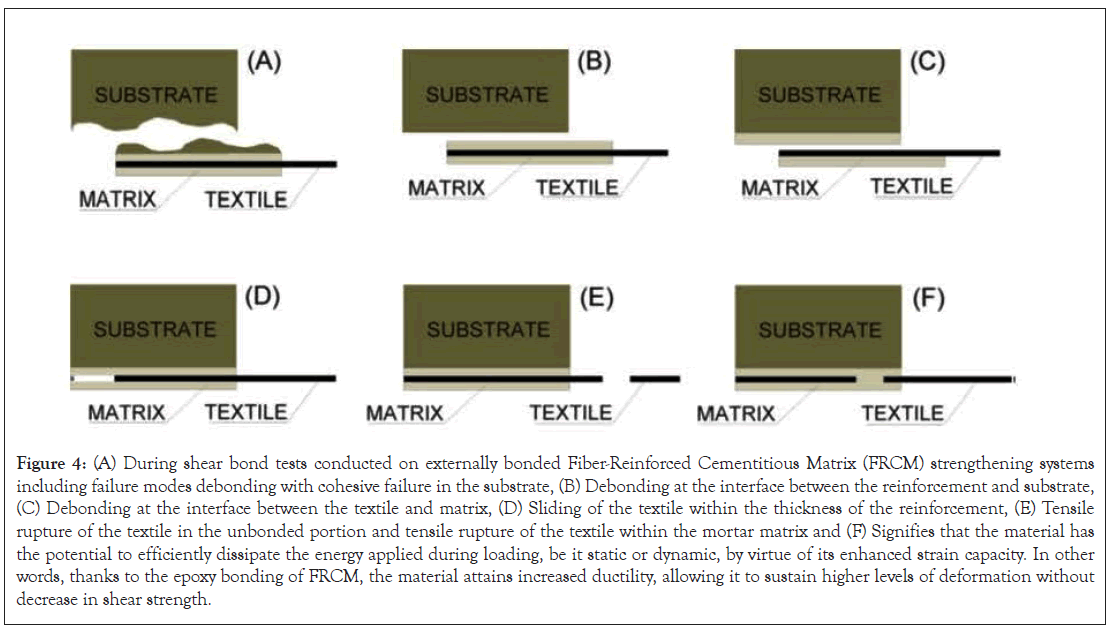
Figure 4: (A) During shear bond tests conducted on externally bonded Fiber-Reinforced Cementitious Matrix (FRCM) strengthening systems including failure modes debonding with cohesive failure in the substrate, (B) Debonding at the interface between the reinforcement and substrate, (C) Debonding at the interface between the textile and matrix, (D) Sliding of the textile within the thickness of the reinforcement, (E) Tensile rupture of the textile in the unbonded portion and tensile rupture of the textile within the mortar matrix and (F) Signifies that the material has the potential to efficiently dissipate the energy applied during loading, be it static or dynamic, by virtue of its enhanced strain capacity. In other words, thanks to the epoxy bonding of FRCM, the material attains increased ductility, allowing it to sustain higher levels of deformation without decrease in shear strength.
Typically, the first three failure modes (A, B, and C) exhibit a force slip curve with a nearly flat branch, followed by a brittle failure (Figure 5a). Failure mode D is characterized by a gradual decrease in load due to the progressive loss of friction as the textile slides within the mortar (Figure 5b). In contrast, failure mode E is associated with sudden load reductions caused by the tensile failure of the textile bundles, which may occur before reaching the flat branch of the curve (Figure 5c). Lastly, the response curve related to failure mode F generally displays a sudden reduction followed by a slight further decrease in load. In this case, failure is initiated by the telescopic rupture of the wire bundles, followed by the slipping of the initial portion of the textile out of the mortar (Figure 5d).
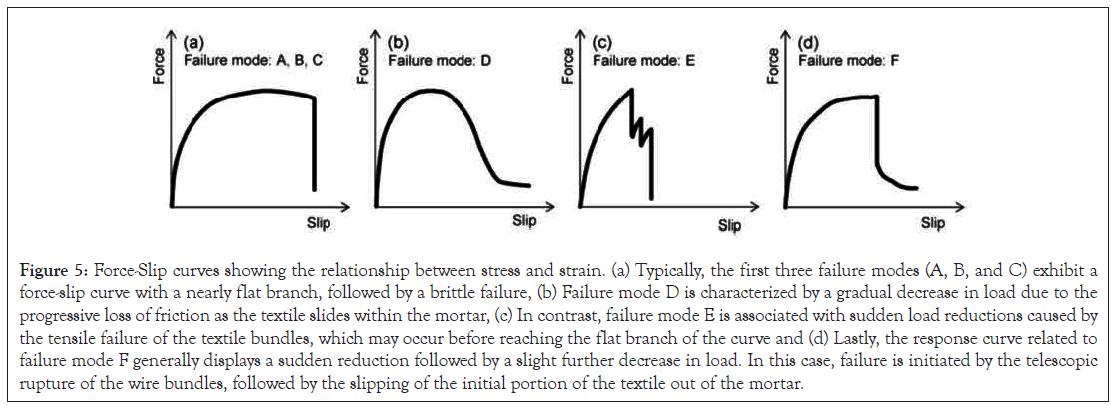
Figure 5: Force-Slip curves showing the relationship between stress and strain. (a) Typically, the first three failure modes (A, B, and C) exhibit a force-slip curve with a nearly flat branch, followed by a brittle failure, (b) Failure mode D is characterized by a gradual decrease in load due to the progressive loss of friction as the textile slides within the mortar, (c) In contrast, failure mode E is associated with sudden load reductions caused by the tensile failure of the textile bundles, which may occur before reaching the flat branch of the curve and (d) Lastly, the response curve related to failure mode F generally displays a sudden reduction followed by a slight further decrease in load. In this case, failure is initiated by the telescopic rupture of the wire bundles, followed by the slipping of the initial portion of the textile out of the mortar.
Shear bond tests allow for assessing the effectiveness of load transfer between the substrate and reinforcement, activating the weakest failure mechanism. On the other hand, pull off tests that apply a normal tensile stress to the substrate to reinforcement interface do not detect certain failure modes, namely the sliding of the textile (mode D) or the tensile rupture (modes E and F).Figure 6 portrays the conventional strain-stress curve of externally bonded Fiber-Reinforced Cementitious Matrix (FRCM) materials, which encompasses three distinct stages (Ascione et al. [9] ). The evaluation of these stages will rely upon the outcomes derived from the experimental study. Nevertheless, the graphical representation signifies that the material has the potential to efficiently dissipate the energy applied during loading, be it static or dynamic, by virtue of its enhanced strain capacity. In other words, thanks to the epoxy bonding of FRCM, the material attains increased ductility, allowing it to sustain higher levels of deformation without decrease in shear strength. In the shear bond tests (Figure 6a), the bond strength between the FRCM reinforcement and the substrate is evaluated. This test measures the ability of the reinforcement to adhere to the substrate and resist sliding or debonding. The results of shear bond tests provide crucial information about the effectiveness of load transfer between the reinforcement and the substrate. On the other hand, direct tensile tests (Figure 6b) assess the tensile strength of the FRCM reinforcement itself. These tests apply a direct force to the reinforcement to evaluate its capacity to withstand tension without failure. The results of direct tensile tests provide insights into the overall mechanical properties and performance of the FRCM reinforcement. By combining the results of both shear bond tests and direct tensile tests, a comprehensive qualification of the externally bonded FRCM strength ening system can be obtained. This combined evaluation allows for a more complete understanding of the system’s behavior under different loading conditions, providing valuable data for assessing its suitability and effectiveness in practical applications.
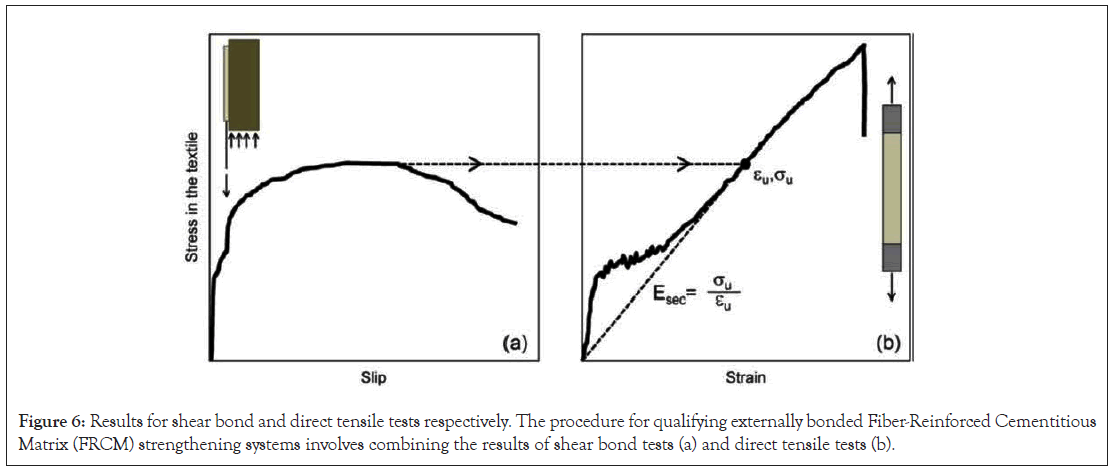
Figure 6: Results for shear bond and direct tensile tests respectively. The procedure for qualifying externally bonded Fiber-Reinforced Cementitious Matrix (FRCM) strengthening systems involves combining the results of shear bond tests (a) and direct tensile tests (b).
This study focuses on investigating the tensile behavior of the Fiber-Reinforced Cementitious Matrix (FRCM) by utilizing a clevis system, as depicted in Figure 7.
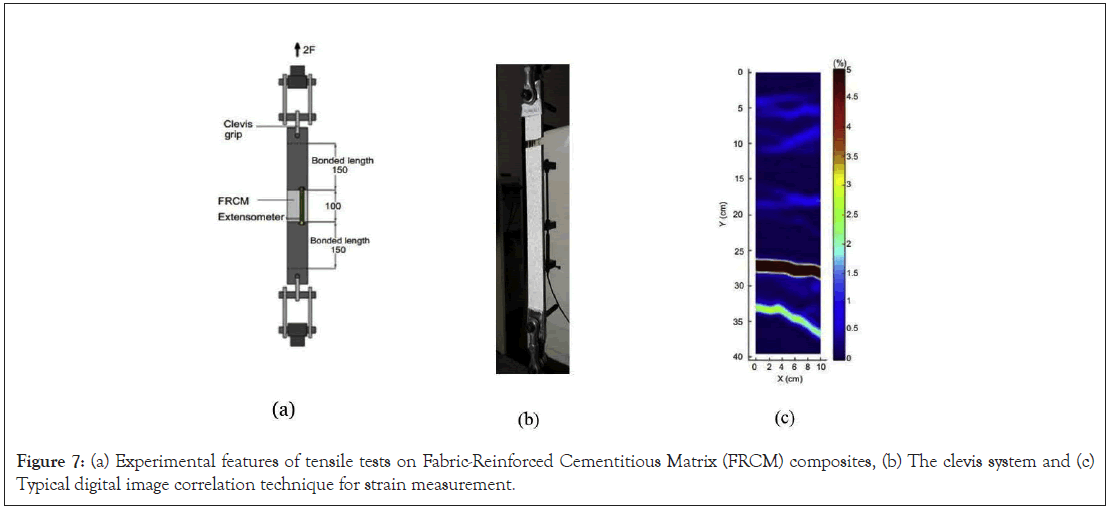
Figure 7: (a) Experimental features of tensile tests on Fabric-Reinforced Cementitious Matrix (FRCM) composites, (b) The clevis system and (c) Typical digital image correlation technique for strain measurement.
The clevis system involves attaching metal tabs of appropriate bonding length to the ends of the FRCM specimen using epoxy resin. Subsequently, a grip system is employed to establish a pinned-end support [1], which allows for multiple degrees of freedom for the specimen. This specific testing configuration minimizes bending moments at the specimen ends and permits potential slippage of the fabric from the matrix. Essentially, only shear stresses are transmitted to the specimen. The testing procedure employed in this study primarily influences the failure modes exhibited by the FRCM specimens. Axial deformations during testing are typically measured using strain gauges, Linear Variable Differential Transformers (LVDTs), or extensometers. These measurement techniques enable the assessment of the extent of axial deformation experienced by the specimen. The properties of Textile Reinforced Concrete (TRC) are given in Table 1, ranging from dimensional features to mechanical characteristics. Reinforcement rate is dedicated as 0.024%. In this experiment, glass fibers and cement matrix were used as the components of FRCM (TRC, etc.). Figure 3 shows the results of tensile testing.
The stress-strain curve of a Textile-Reinforced Concrete (TRC) specimen is typically derived through uniaxial tensile testing. The resulting behavior of Fiber-Reinforced Cementitious Matrix (FRCM) materials under tensile loading is commonly represented by a trilinear curve, which encompasses three distinct stages. In Figure 8, these stages are evident, starting with stage I characterized by a linear stress-strain relationship that reflects the uncracked state of the TRC specimen. During this stage, the FRCM functions as a composite material. Moving to stage II, transverse cracks begin to form within the inorganic matrix of the specimen. These cracks may occur at specific locations along the specimen due to the tensile properties of the matrix. In this stage, a noticeable decrease in stiffness can be observed as the resisting area undergoes significant deformation (Figure 8).
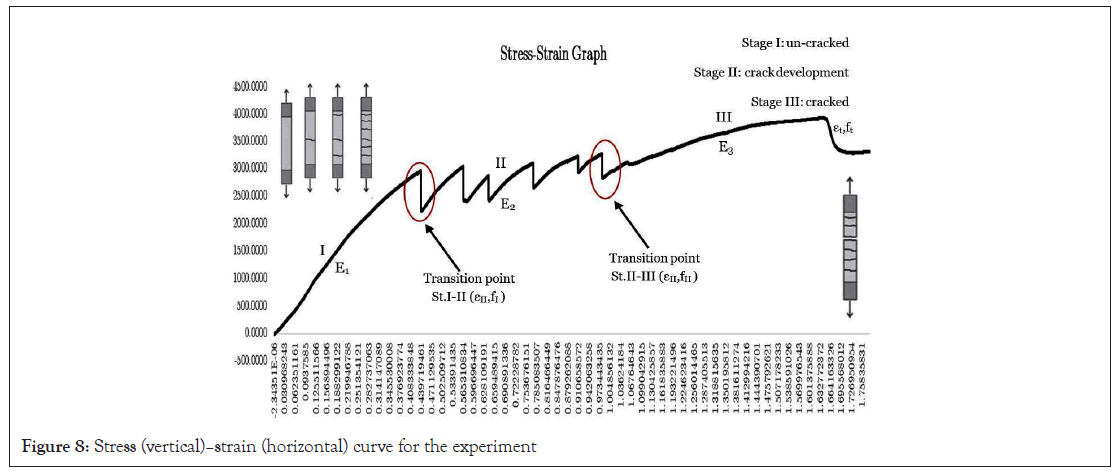
Figure 8: Stress (vertical)–strain (horizontal) curve for the experiment
Stage III of the stress-strain curve is marked by the widening of existing matrix cracks and subsequent further loading. During this stage, the fabric component of the FRCM system bears the majority of the tensile load, resulting in a slope of the stress strain curve that is typically associated with the Modulus of Elasticity of the textile (Etextile). However, when the uncracked matrix between consecutive cracks continues to carry the tensile load, the slope of the stress-strain curve of the FRCM aligns with that of the dry textile fabric itself.
In the final portion of the stress-strain curve, the existing cracks continue to widen until the FRCM ultimately fails. This failure is generally associated with a brittle failure mechanism. However, it is important to note that after the sharp decrease in stiffness, the behavior of FRCM exhibits a pseudo ductile characteristic, displaying a relatively short process.In summary, the stress-strain behaviour of FRCM materials can be effectively described using a trilinear curve, with distinct stages representing the uncracked state, the formation of transverse cracks, and the widening of existing cracks. Understanding the behaviour of FRCM under tensile loading is crucial for optimizing its performance and ensuring its suitability for various applications.
This article presents an intriguing experimental study that explores the fascinating behavior of Fiber-Reinforced Cementitious Matrix (FRCM) composites under tensile loading. Recent research has sparked excitement surrounding FRCM composites, particularly regarding their performance in uniaxial tensile loading scenarios. These composites exhibit exceptional tensile strength, making them highly promising for diverse applications. Through basic and meticulous experimental test and rigorous theoretical analyses, this study reveals captivating findings that shed light on the macromechanical behavior of FRCM composites. The key conclusions are as follows:
Trilinear stress-strain behaviour
Monotonic tensile loading unveils a remarkable trilinear stress- strain diagram that characterizes the macromechanical behavior of FRCM systems. This diagram showcases three distinct branches, each representing a different stage in the composite’s response. The initial branch reflects the pristine, uncracked state of the matrix with maximum stiffness and resilience. The second branch captures the progressive cracking of the matrix, resulting in a significant dropin stiffness. Finally, the third branch demonstrates the widening of matrix cracks, accompanied by a stiffness level comparable to that of the fabric reinforcement.
Theoretical vs. experimental validation
A thrilling aspect of this study is the striking alignment between theoretical predictions and actual experimental results. The stress-strain diagram derived from rigorous theoretical analysis closely matches the behavior observed during testing, reinforcing the accuracy and reliability of the findings. This investigation provides valuable insights into the macroscopic behavior of FRCM composites under different loading conditions, contributing to our understanding of their mechanical properties. Furthermore, these findings pave the way for future advancements and innovations in structural engineering and construction practices. By unraveling the intricacies of FRCM composites and their response to tensile loading, exciting possibilities arise for designing resilient structures capable of withstanding natural forces. The potential applications of these remarkable materials range from infrastructure rehabilitation to seismic retrofitting. Continued exploration and collaboration between researchers and industry professionals are vital in fully harnessing the potential of FRCM composites, revolutionizing the construction and fortification of our built environment. The journey to fully exploit the extraordinary properties of these materials has just begun, and the discoveries that lie ahead are certain to captivate and inspire us all.
The authors declare that they have no known competing financial interests or personal relationships that could have appeared to influence the work reported in this paper.
The author acknowledges Prof. Sofiane Amziane, Ph.D to share the experimental results to analyze and interpret them.
Orhun Kalyoncu: Conceptualization, Methodology, Validation, Formal analysis, Investigation, Visualization, Writing Original Draft.
Citation: Kalyoncu O (2023) Enhancing the Structural Performance of Vegetal Concrete: An Experimental Study on the Tensile Behavior of Fabric Reinforced Cementitious Matrix Composite. Int J Adv Technol. 14:260.
Received: 04-Sep-2023, Manuscript No. IJOAT-23-25924; Editor assigned: 06-Sep-2023, Pre QC No. IJOAT-23-25924 (PQ); Reviewed: 20-Sep-2023, QC No. IJOAT-23-25924; Revised: 27-Sep-2023, Manuscript No. IJOAT-23-25924 (R); Published: 05-Oct-2023 , DOI: 10.35248/0976-4860.23.14.260
Copyright: © 2023 Kalyoncu O. This is an open-access article distributed under the terms of the Creative Commons Attribution License, which permits unrestricted use, distribution, and reproduction in any medium, provided the original author and source are credited.